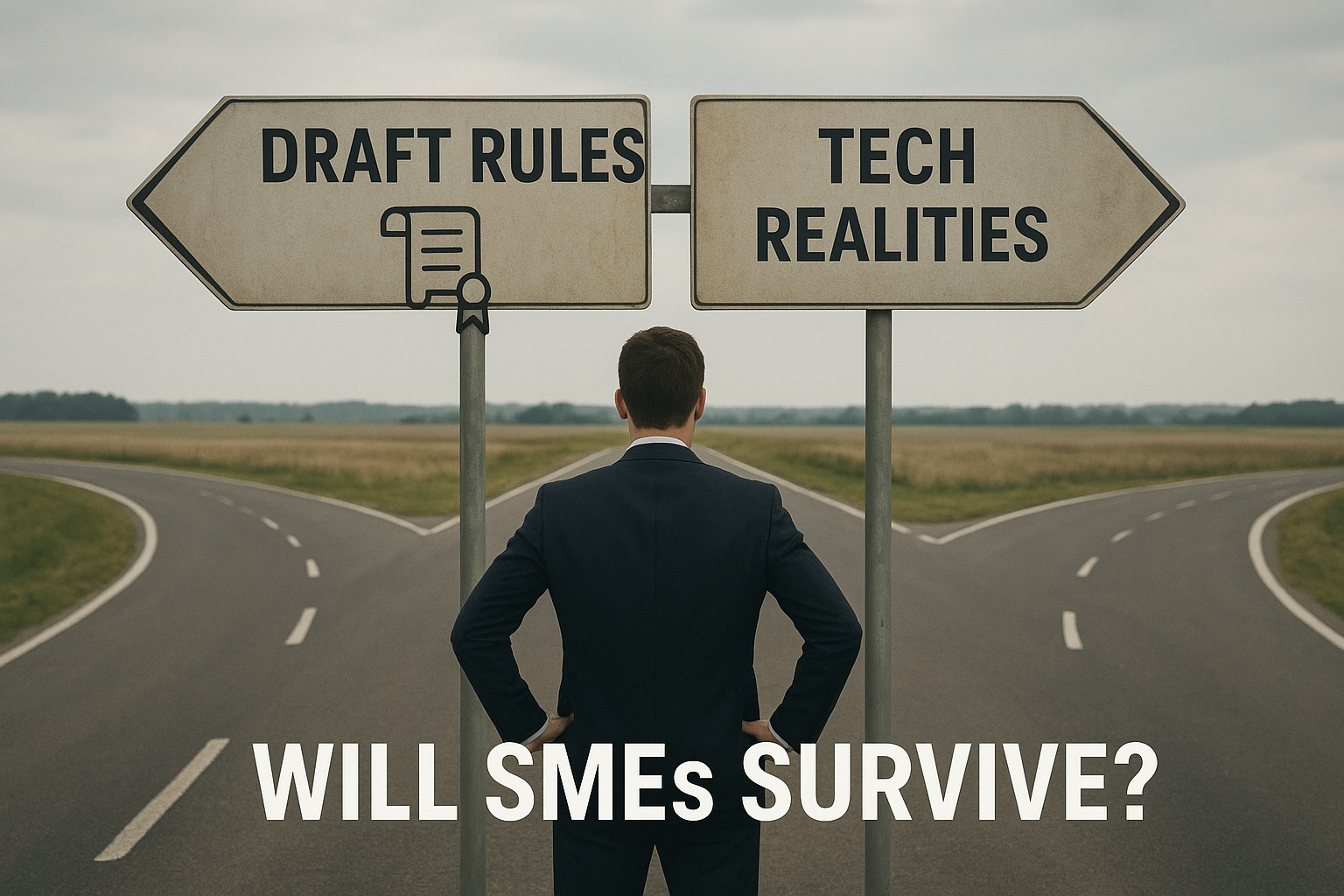Draft Rules & Tech Realities: Will SMEs Survive?
By Aparna Mitra, 15th May 2025

India’s Digital Personal Data Protection (DPDP) Act, 2023 is inching toward becoming operational through the Draft DPDP Rules, 2025. For large companies, this mostly means scaling privacy programs they already started for global laws. For startups and SMEs, though, the draft rules read like a dense checklist that hits three big nerves:
Consent managers (who they are, when they’re needed, and what registration entails),
Erasure protocols (including the “erase after inactivity + 48-hour notice” construct),
Data Protection Impact Assessments (DPIAs)(who must do them, how often, and what they include).
This Article unpacks what the draft rules currently say (and just as importantly, what they don’t say yet), then translates the legalese into the technology and operational realities a smaller organization will have to navigate. You’ll also find realistic examples throughout. Where relevant, I’ve cited authoritative commentary and publicly available summaries so you can cross-check the details.
Note on status: The Act receive presidential assent on August 11, 2023, but as of August 2025, full enforcement is still pending formal notification—even though the draft
rules have been published and consulted upon. So, compliance work is “now-or-soon,” not “someday.”
The core pillars SMEs must pay attention to
1) Consent Managers: a new regulated role in the ecosystem
What the rules signal
- The DPDP framework introduces Consent Managers—specialized, registered entities that provide an accessible, transparent, interoperable platform for data principals (people) to give, manage, review, and withdraw consent. They must register with the Data Protection Board of India (DPBI) and meet technical, operational, and financial criteria.
- Multiple briefings and analyses of the draft rules indicate baseline eligibility such as being an India-incorporated company and maintaining minimum net worth (around ₹2 crore), along with interoperability, audit trails, and “data-blind” operations.
- MeitY has also published technical guidance for Consent Management Systems (CMS)—a Business Requirements Document (BRD/BRS) that outlines lifecycle management of consent (collection, validation, updates, withdrawal). This suggests the government is nudging the market toward common pipes and interfaces.
What this means for SMEs
Most SMEs won’t be consent managers. But they will need to interact with them if the ecosystem evolves toward centralized, interoperable consent rails—especially for consumer-facing apps operating at scale. Expect:
- Procurement decisions: Choosing a consent manager (or CMS vendor) that is registered/registration-ready, and can integrate with your stack via APIs.
- Data mapping uplift: Your data flows, purpose categories, and retention rules must be machine-readable for an external platform to honor them. No more “consent buried in UI copy + a spreadsheet.”
- Change management: If CMS standardizes how consent is given/withdrawn, your backend must propagate consent state across systems (analytics tools, marketing automation, CRMs, data lakes).
Fictitious example (consumer app)
“SnackKart,” a 40-employee grocery-delivery startup in Pune, uses a patchwork of consent banners and in-app toggles. As CMS requirements mature, SnackKart decides to integrate with “OkConsent,” a registered consent manager. They must: (a) tag events and data streams by purpose (order fulfillment, personalization, ads); (b) implement webhooks to stop personalization if
a user withdraws consent; and (c) maintain an audit trail showing when consent was asked, given, updated, or withdrawn. The integration took 6 engineering sprints, plus a new privacy engineer role shared with DevOps.
Fictitious example (B2B SaaS)
“LedgerLoom,” a 22-person fintech SaaS, processes limited personal data (business user names and emails). They don’t need a consent manager integration on day one, because their processing rests primarily on contractual necessity.
However, they still adopt a lightweight consent/cookie banner and store proof of consent to marketing emails in their CRM. They keep an eye on CMS standards for future enterprise RFPs that might require “plug-and-play” compatibility.
2)Erasure protocols: inactivity timers + 48-hour advance notice
What the rules signal
Draft Rule 8 (as summarized by multiple commentators) sets a default erasure trigger linked to inactivity: erase personal data after three years from the last interaction or from commencement of the rules—whichever is later—unless the person engages again or exercises a data right within the period. The draft also contemplates 48-hour prior notice before erasure.
This sits alongside the Act’s right to erasure (on request), subject to legal retention needs.
What this means for SMEs
This is not just a policy tweak. It’s a systems and operations project:
- Identity + activity correlation: You must reliably determine the last interaction date for a person across touchpoints (app logins, purchases, support tickets, email clicks).
Data lineage and locations: Erasure requires you to know where the data lives (primary DB, caches, logs backups, third-party processors) and whether you can either delete or effectively render it irretrievable in backups.
Notification machinery: The 48-hour advance notice implies a scheduler that can look ahead, tee up notifications, and allow users to “re-engage” to avoid deletion.
Edge cases: Partial erasure (delete marketing profiles but retain invoices for tax), account reactivation, and multi-account duplicates.
Fictitious example (marketplace SME)
“BookBindi,” a 35-employee artisan marketplace in Jaipur, keeps seller and buyer profiles. Their CTO builds an “erasure engine”: a nightly job calculates who’s set to hit the 3-year inactivity threshold in 2 days, sends email/app push (“We’ll delete your account in 48 hours unless you log in or write us”), and, if no engagement occurs, soft-deletes the profile and hard-deletes marketing data, while retaining invoices for statutory periods. Processors (email vendor, analytics CDP) are hit with delete webhooks and must confirm within SLA. The team maintains an erasure ledger recording who, what, when, where (system), and why (draft Rule 8).
Fictitious example (EdTech SME)
“TutorTrail,” 18 people in Bengaluru, holds student lesson recordings for quality and for student replays. The team revises their retention table: recordings auto-expire at 12 months unless a student opts to extend (opt-in is a click in their dashboard). The 48-hour notice runs as a batch email. Analytics logs store only pseudonymized IDs; raw data older than 90 days is aggregated. Their cloud storage now tags objects with retention metadata so lifecycle policies can delete files without engineering action.
3) DPIAs and “Significant Data Fiduciaries” (SDFs)
What the rules signal
The Act empowers the government to designate certain controllers as Significant Data Fiduciaries (SDFs) based on volume/sensitivity of data and risk to rights. The draft rules sketch obligations that include doing DPIAs, keeping algorithmic due diligence, and periodically submitting DPIA results (e.g., annually) to the DPBI.
What this means for SMEs
Not every SME will be an SDF. But some startups can be flagged (think healthtech, fintech, identity verification services, adtech) if their processing scale or risk profile is high. Even if you’re not designated SDF, enterprise buyers will increasingly require DPIA-ready documentation in vendor due diligence. Think of DPIA as a structured risk assessment covering purpose, necessity, data flows, risks, and mitigations.
Fictitious example (Healthtech SME likely to be SDF)
“KareKit,” a tele-consultation startup with 55 people, processes medical histories and prescriptions. They proactively run a DPIA template aligned to global practice: describe processing, assess risks (re-identification in analytics, physician impersonation risk), map mitigations (MFA for doctors, differential privacy for analytics exports, strict role-based access), and document residual risk + sign-offs. If later designated an SDF, they’re not scrambling—they already have an annual DPIA cadence.
Fictitiousexample (adtech SME not designated SDF—yet)
“PixelPaisa,” 28-person martech firm, primarily processes pseudonymous web analytics. They’re not SDF, but a major publisher insists on a DPIA summary. PixelPaisa builds one: lists cookie categories, retention, opt-out links, consent signals honored (from browser + consent manager). They add a plan to drop IP addresses at ingest and rely on coarse geolocation only. This turns into a sales differentiator.
Other draft-rule signals SMEs should watch
A. Breach notifications and thresholds
The draft rules (as summarized in industry comments) contemplate notifications to both the DPBI and affected individuals, prompting calls for clear thresholds to prioritize serious harms and avoid “notification fatigue.” Expect final rules to clarify when and how to notify. Build for incident classification now. itic.org
B. Cross-border transfers and (possible) localization nudges
While the Act framed cross-border transfers around government-notified conditions (rather than blanket localization), trade associations have warned that draft rule language could re-introduce localization-like constraints. If your stack relies on foreign clouds/processors, track this closely and keep a regionalization
plan in your back pocket.
C. Children’s data, age gating, and parental consent
Early commentary suggests stricter verification for minors and parental consent for under-18s, with details to
be refined. If your product touches minors, expect age-assurance work (low-friction verification signals, safe defaults).
Turning law into build tickets: a pragmatic SME roadmap
Below is a neutral, build-oriented checklist that can be adapted regardless of your sector.
1) Map data like an engineer, not a lawyer
Inventory systems (prod DBs, data lakes, caches, logs, SaaS tools).
Tag data by purpose (fulfillment, support, personalization, ads, analytics, legal).
Mark retention per dataset (business minimum + legal maximum).
Note transfers (processors, cross-border endpoints).
This underpinning is essential for CMS integrations and erasure automation.
2) Stand up consent plumbing
Frontend: capture granular, revocable consent (especially for non-essential processing) and persist the signal with proof (who/what/when/how).
Backend: propagate consent state via feature flags or policy checks (e.g., personalization = on only if consent.personalization = true).
Vendor enforcement: ensure your ESP, analytics, and ads platforms honor withdrawal within SLA.
CMS readiness: design APIs/webhooks to sync consent with a future registered consent manager.
3) Build an erasure engine (even if you’re small)
Identify the data subject (unified IDs across systems).
Calculate inactivity windows; schedule 48-hour notices.
Execute deletions with idempotent jobs (retries are safe; partial failure paths are logged).
Verify processors’ deletions (webhooks + signed receipts).
Handle backups: document restore policies and data tombstoning.
4) Prepare a DPIA template
Even if you’re not an SDF, keep a lightweight DPIA ready: purpose, lawful basis/consent, data categories, recipients, retention, risk analysis, mitigations, and residual risk.
Add algorithmic due diligence if you use ML: data sourcing, bias checks, model monitoring, appeal channels.
5) Incident response that scales down
Define severity levels.
Pre-draft notifications to users and (if required) DPBI.
Run an exercise twice a year with the founders in the room.
6) Procurement and contracts
Amend DPA addenda with processors to include erasure SLAs, breach timelines, and cross-border representations aligned to the draft rules.
For any consent tech, ensure interoperability commitments and futureproofing for registration requirements.
Cost thinking for SMEs: where the money (and time) will go
One-time costs
Data mapping sprint (2–6 weeks): engineers + a PM, sometimes a privacy consultant.
Consent plumbing (2–8 weeks): depends on product complexity and number of downstream tools.
Erasure automation (2–6 weeks): scheduler, notifications, multi-system deletes, vendor calls.
DPIA kit (1–2 weeks): template + a run-through on your highest-risk flow.
Recurring costs
Privacy champion time (0.2–0.5 FTE) to maintain registers, review vendors, run DPIAs when features change.
Annual DPIA if designated an SDF (or if customers demand it in vendor reviews).
Processor oversight: quarterly spot checks, breach playbooks, and deletion receipts.
CMS/Consent Manager fees once the market standardizes.
Where small teams get leverage
Use cloud lifecycle policies for retention (object storage auto-delete).
Prefer server-side consent enforcement so you don’t rebuild clients for every change.
Consolidate analytics (fewer tools = fewer integrations to police).
Adopt privacy-by-contract: negotiate standard clauses once, reuse across vendors.
Sector-specific notes (brief)
Fintech: Expect more scrutiny on profiling, device signals, and cross-border fraud tooling. Bank partners will ask for DPIA extracts.
Health/Wellness: Sensitive data + telehealth means you may approach SDF territory earlier; get access controls and audit logs in order.
EdTech: If minors are involved, build age-assurance early and keep content/ads strictly separated.
Marketplaces/E-commerce: Erasure across catalogs, reviews, and logistics is tricky. Start with data ownership models (e.g., sellers’ business contact data vs buyer personal data) and treat them differently.
B2B SaaS: Many customers will bake DPDP clauses into MSAs. Even if your exposure is “low,” you’ll need DPIA-ready documentation and log-level retention hygiene.
Objective risk/benefit balance for SMEs
Benefits (why these rules help the ecosystem long-term)
Interoperable consent can improve user trust and reduce conflicting consent states across apps.
Inactivity-based erasure curbs data hoarding and breach impact.
DPIAs standardize privacy risk thinking and can help secure enterprise deals.
Risks/Challenge (why SMEs may struggle)
Up-front engineering for consent/erasure is non-trivial.
Vendor enforcement creates dependencies (your deletion is only as good as your slowest processor).
Ambiguities (e.g., exact triggers/thresholds for breach notice; how far localization nudges go) can complicate architecture choices until clarified.
An objective takeaway: None of the above is unmanageable for a small team—but it does require intentional
prioritization and some runway.
A neutral readiness plan you can copy-paste
Appoint a privacy champion (someone who can herd engineering, product, and legal tasks).
Complete a data inventory with purposes, processors, and retention.
Implement consent plumbing (backend enforcement + logs).
Build the erasure engine (scheduler, notices, deletes, receipts).
Draft a DPIA template and run it on your riskiest flow.
Audit vendors for deletion and breach SLAs.
Write the playbooks (breach, data subject requests, incident comms).
Track regulatory changes (consent manager registration specs, cross-border conditions) and keep a light architecture decision record to show reasoned choices.
Fictitious mini-case studies (objective outcomes)
Case A: “QuickQuot” (insurance quote widget, 14 people)
Context: Collects phone + vehicle numbers; pushes leads to insurers.
Actions: Built consent toggles for marketing; retains quotes for 12 months unless converted; auto-erases stale leads after 12 months (emails/push 48 hours prior).
Result: Lead quality rose (fewer spam requests), partner insurer compliance teams fast-tracked onboarding due to clear deletion receipts.
Risk: Conversion retargeting dipped until they redesigned personalization as opt-in. Net customer complaints fell.
Case B: “FitFlock” (fitness marketplace, 32 people)
Context: Sells class passes; uses three analytics tools and a CRM.
Actions: Consolidated to one analytics tool; wired consent via a server-side gateway; normalized IDs; built an “erase everywhere” routine + processor receipts.
Result: Reduced analytics costs by 40%, eliminated duplicate profiles, passed an enterprise buyer’s privacy review.
Risk: Two months of engineering time diverted from growth features.
Case C: “ClinicLoop” (telehealth, 60 people; likely SDF)
Context: Video consults + e-prescriptions; ML triage assistant.
Actions: DPIA focused on model hallucination risk and mis-triage, added doctor-in-the-loop checks; restricted cross-border analytics; appointed a DPO-equivalent contact.
Result: Secured a hospital pilot; incident drill revealed a logging misconfig, fixed before go-live.
Risk: More ops overhead, but clearer enterprise sales path.
What to watch next (objectively)
Finalization & notification: When the draft becomes formalized and notified, specific dates and grace periods will matter. Track MeitY and DPBI communications.
Consent manager registry: Who gets registered first, and what API specs/interoperability proofs are accepted?
Cross-border conditions: Final position on localization vs. transfer permissions will influence cloud and vendor strategy.
Breach thresholds: Expect clarifications to avoid over-notification. Prepare anyway.
Conclusion (neutral, evidence-based)
The Draft DPDP Rules, 2025 take the DPDP Act’s broad principles and translate them into actionable obligations. For SMEs, the heavy lifts are consent plumbing, erasure automation, and being DPIA-ready—especially if you operate in higher-risk domains that could be tagged as Significant Data Fiduciaries.






